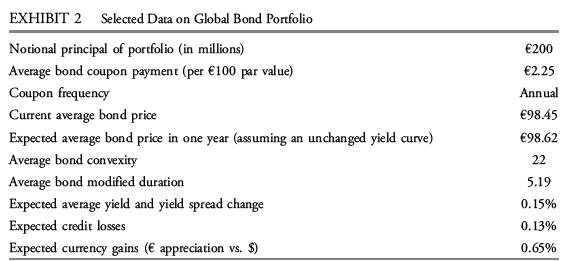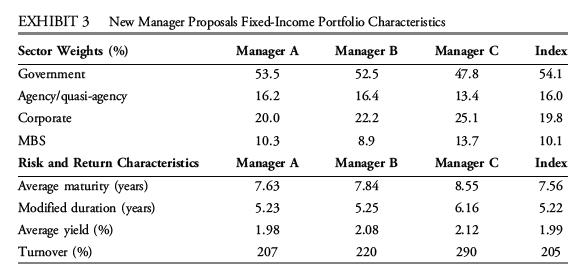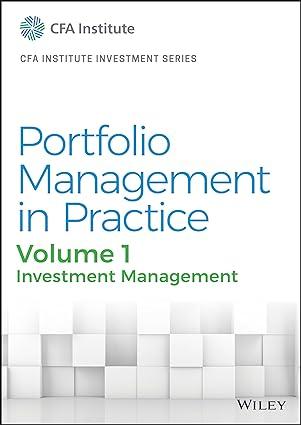Based on Exhibit 2, the total expected return of the funds global bond portfolio is closest to:
Question:
Based on Exhibit 2, the total expected return of the fund’s global bond portfolio is closest to:
A. 0.90%.
B. 2.20%.
C. 3.76%.
Celia Deveraux is chief investment officer for the Topanga Investors Fund, which invests in equities and fixed income. The clients in the fund are all taxable investors. The fixed-income allocation includes a domestic (US) bond portfolio and an externally managed global bond portfolio.
The domestic bond portfolio has a total return mandate, which specifies a long-term return objective of 25 basis points (bps) over the benchmark index. Relative to the benchmark, small deviations in sector weightings are permitted, such risk factors as duration must closely match, and tracking error is expected to be less than 50 bps per year.
The objectives for the domestic bond portfolio include the ability to fund future liabilities, protect interest income from short-term inflation, and minimize the correlation with the fund’s equity portfolio. The correlation between the fund’s domestic bond portfolio and equity portfolio is currently 0.14. Deveraux plans to reduce the fund’s equity allocation and increase the allocation to the domestic bond portfolio. She reviews two possible investment strategies
Strategy 1 Purchase AAA rated fixed-coupon corporate bonds with a modified duration of two years and a correlation coefficient with the equity portfolio of –0.15.
Strategy 2 Purchase US government agency floating-coupon bonds with a modified duration of one month and a correlation coefficient with the equity portfolio of –0.10.
Deveraux realizes that the fund’s return may decrease if the equity allocation of the fund is reduced. Deveraux decides to liquidate $20 million of US Treasuries that are currently owned and to invest the proceeds in the US corporate bond sector. To fulfill this strategy, Deveraux asks Dan Foster, a newly hired analyst for the fund, to recommend Treasuries to sell and corporate bonds to purchase.
Foster recommends Treasuries from the existing portfolio that he believes are overvalued and will generate capital gains. Deveraux asks Foster why he chose only overvalued bonds with capital gains and did not include any bonds with capital losses. Foster responds with two statements.
Statement 1. Taxable investors should prioritize selling overvalued bonds and always sell them before selling bonds that are viewed as fairly valued or undervalued.
Statement 2. Taxable investors should never intentionally realize capital losses.
Regarding the purchase of corporate bonds, Foster collects relevant data, which are presented in Exhibit 1.

Deveraux and Foster review the total expected 12-month return (assuming no reinvestment income) for the global bond portfolio. Selected financial data are presented in Exhibit 2.

Deveraux contemplates adding a new manager to the global bond portfolio. She reviews three proposals and determines that each manager uses the same index as its benchmark but pursues a different total return approach, as presented in Exhibit 3.

Step by Step Answer:






